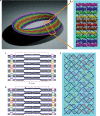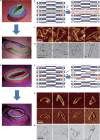Folding and cutting DNA into reconfigurable topological nanostructures
- PMID: 20890274
- PMCID: PMC3071358
- DOI: 10.1038/nnano.2010.193
Folding and cutting DNA into reconfigurable topological nanostructures
Abstract
Topology is the mathematical study of the spatial properties that are preserved through the deformation, twisting and stretching of objects. Topological architectures are common in nature and can be seen, for example, in DNA molecules that condense and relax during cellular events. Synthetic topological nanostructures, such as catenanes and rotaxanes, have been engineered using supramolecular chemistry, but the fabrication of complex and reconfigurable structures remains challenging. Here, we show that DNA origami can be used to assemble a Möbius strip, a topological ribbon-like structure that has only one side. In addition, we show that the DNA Möbius strip can be reconfigured through strand displacement to create topological objects such as supercoiled ring and catenane structures. This DNA fold-and-cut strategy, analogous to Japanese kirigami, may be used to create and reconfigure programmable topological structures that are unprecedented in molecular engineering.
Figures



References
-
- Bates AD, Maxwell A. DNA Topology. 2nd edn Oxford Univ. Press; 2005.
-
- Sauvage JP, Dietrich-Buchecker C, editors. Molecular Catenane, Rotaxanes and Knots: A Journey through the World of Molecular Topology. Wiley-VCH; 1999.
-
- Rothemund PWK. Folding DNA to create nanoscale shapes and patterns. Nature. 2006;440:297–302. - PubMed
-
- Starostin EL, Van Der Heijden GHM. The shape of a Möbius strip. Nature Mater. 2007;6:563–567. - PubMed
-
- Yoon ZS, Osuka A, Kim D. Möbius aromaticity and antiaromaticity in expanded porphyrins. Nature Chem. 2009;1:113–122. - PubMed
Publication types
MeSH terms
Substances
Grants and funding
LinkOut - more resources
Full Text Sources
Other Literature Sources

